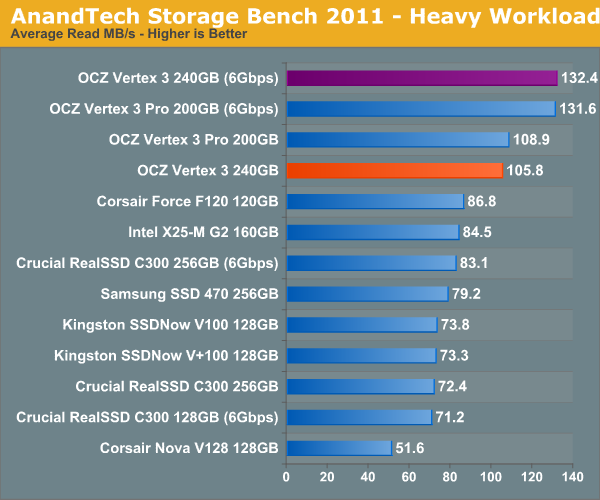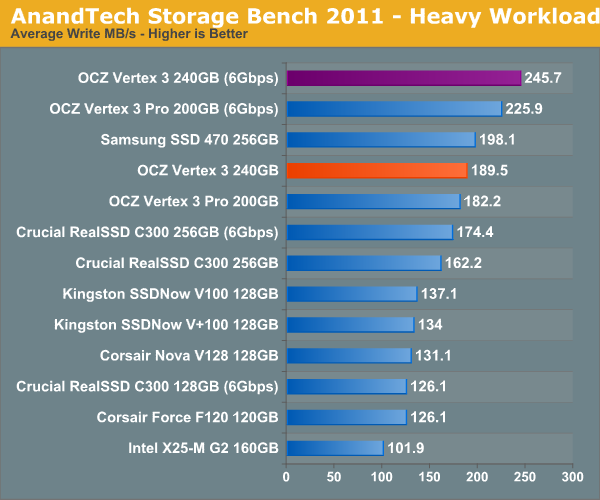OCZ Vertex 3 Preview: Faster and Cheaper than the Vertex 3 Pro
by Anand Lal Shimpi on February 24, 2011 9:02 AM ESTAnandTech Storage Bench 2011: Much Heavier
I didn't expect to have to debut this so soon, but I've been working on updated benchmarks for 2011. Last year we introduced our AnandTech Storage Bench, a suite of benchmarks that took traces of real OS/application usage and played them back in a repeatable manner. I assembled the traces myself out of frustration with the majority of what we have today in terms of SSD benchmarks.
Although the AnandTech Storage Bench tests did a good job of characterizing SSD performance, they weren't stressful enough. All of the tests performed less than 10GB of reads/writes and typically involved only 4GB of writes specifically. That's not even enough exceed the spare area on most SSDs. Most canned SSD benchmarks don't even come close to writing a single gigabyte of data, but that doesn't mean that simply writing 4GB is acceptable.
Originally I kept the benchmarks short enough that they wouldn't be a burden to run (~30 minutes) but long enough that they were representative of what a power user might do with their system.
Not too long ago I tweeted that I had created what I referred to as the Mother of All SSD Benchmarks (MOASB). Rather than only writing 4GB of data to the drive, this benchmark writes 106.32GB. It's the load you'd put on a drive after nearly two weeks of constant usage. And it takes a *long* time to run.
I'll be sharing the full details of the benchmark in some upcoming SSD articles (again, I wasn't expecting to have to introduce this today so I'm a bit ill prepared) but here are some details:
1) The MOASB, officially called AnandTech Storage Bench 2011 - Heavy Workload, mainly focuses on the times when your I/O activity is the highest. There is a lot of downloading and application installing that happens during the course of this test. My thinking was that it's during application installs, file copies, downloading and multitasking with all of this that you can really notice performance differences between drives.
2) I tried to cover as many bases as possible with the software I incorporated into this test. There's a lot of photo editing in Photoshop, HTML editing in Dreamweaver, web browsing, game playing/level loading (Starcraft II & WoW are both a part of the test) as well as general use stuff (application installing, virus scanning). I included a large amount of email downloading, document creation and editing as well. To top it all off I even use Visual Studio 2008 to build Chromium during the test.
Many of you have asked for a better way to really characterize performance. Simply looking at IOPS doesn't really say much. As a result I'm going to be presenting Storage Bench 2011 data in a slightly different way. We'll have performance represented as Average MB/s, with higher numbers being better. At the same time I'll be reporting how long the SSD was busy while running this test. These disk busy graphs will show you exactly how much time was shaved off by using a faster drive vs. a slower one during the course of this test. Finally, I will also break out performance into reads, writes and combined. The reason I do this is to help balance out the fact that this test is unusually write intensive, which can often hide the benefits of a drive with good read performance.
There's also a new light workload for 2011. This is a far more reasonable, typical every day use case benchmark. Lots of web browsing, photo editing (but with a greater focus on photo consumption), video playback as well as some application installs and gaming. This test isn't nearly as write intensive as the MOASB but it's still multiple times more write intensive than what we were running last year.
As always I don't believe that these two benchmarks alone are enough to characterize the performance of a drive, but hopefully along with the rest of our tests they will help provide a better idea.
The testbed for Storage Bench 2011 has changed as well. We're now using a Sandy Bridge platform with full 6Gbps support for these tests. All of the older tests are still run on our X58 platform.
AnandTech Storage Bench 2011 - Heavy Workload
We'll start out by looking at average data rate throughout our new heavy workload test:

If we break out our performance results into average read and write speed we get a better idea for the Vertex 3's strengths:


The next three charts just represent the same data, but in a different manner. Instead of looking at average data rate, we're looking at how long the disk was busy for during this entire test. Note that disk busy time excludes any and all idles, this is just how long the SSD was busy doing something:













85 Comments
View All Comments
Cow86 - Thursday, February 24, 2011 - link
This is likely going into my next build ^^ Which is a few months off still, so hopefully the prices will be somewhat favourable by then....vol7ron - Friday, February 25, 2011 - link
let me guess... waiting for z68? :)Rasterman - Thursday, February 24, 2011 - link
Which of the benchmarks relate to loading windows and loading programs and games or levels in games? It would be nice to see how these compare, my guess is its not worth it to upgrade from a Crucial Real SSD C300 256GB to a Vertex 3 256GB as the perceived difference is going to be negligible?Some real world tests would be nice:
fresh load of windows 7
start windows 7 from hibernation
starting major games
loading levels in major games
starting major programs (photoshop, visual studio, windows media player, itunes, outlook)
ImSpartacus - Thursday, February 24, 2011 - link
Well, if you do upgrade from that C300, I would happily take it off your hands.I figure that old hardware is only worth, ohhhh, $100? Yeah, that's about right.
So, what do you say?
Figaro56 - Friday, February 25, 2011 - link
The Crucial C300 256GB drive for $100? Dream on!You can buy one brand new today for $420 shipped at amazon.com. You under estimate the C300, it's still a valid product and $100 is just a ridiculous comment.
vol7ron - Friday, February 25, 2011 - link
brand new != usedwith a used drive, you've already cut into warranty and you've reduced its lifespan (as negligible a point as it may be).
Figaro56 - Friday, February 25, 2011 - link
Then you had better buy a new one then. No one is going to sell their originally priced $600 Crucial RealSSD C300 256GB SSD for $100, especially after this review.There is a margin of real world performance improvement with the Vertex 3 true, but certainly not so superior over the C300 as to make someone crazy enough to sell an 8 month old $600 SSD for $100 as it's "obviously" not obsolete it's just 2nd best. That's just retarded.
These SSD drives have an incredible life span so cutting into the life span over 8 months of use is nebulous. The warranty is only there for warm fuzzies, if it works it works.
jimhsu - Friday, February 25, 2011 - link
I suppose IM's response is a joke considering the OP's question of whether an ultra-fast drive is faster than the super-fast drive that he already has.(For the record, I bought the C300 256GB for $400 in newegg's awesome 20% off sale).
vol7ron - Friday, February 25, 2011 - link
I took it as a joke too, but still you're not going to get top dollar if you're selling a used device. A person would rather go get a refurb.Also, didn't the C300 have many problems that crept up? Not saying it hasn't been solved and the problems weren't rare, but I though a few weeks after Anand got their version, it died - and a few others died as well (betas and productions). For whatever reason, I decided to stay away from Crucial for that reason; not permanently, but in the short run.
I'm more curious to see with what Intel has to offer. Even if they don't introduce a compression algorithm, I like their wear-leveling better - it should require less additional spare NAND and be cheaper in general. And, of course, I like to see how Vertex 3 fares with TRIM as it approaches the capacity limit.
Figaro56 - Tuesday, March 1, 2011 - link
The infamous firmware issue of the Crucial drive was solved, I've never had a problem. This C300 is a very fast SSD and I'm more than happy with it. When an SSD comes along that is actually twice as fast in every bench mark as my C300 256GB SSD then I might feel as though it's obsolete, but we're not there yet.